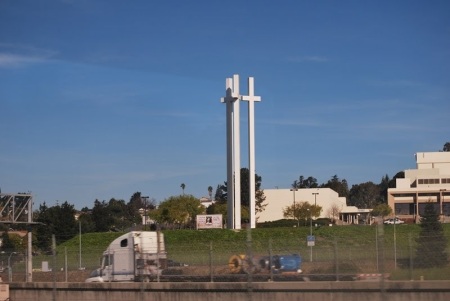
Champs-Élysées, looking down toward the Arc de Triomphe. This was our turf for 10 hours.
0730. Champs-Élysées day. Have no idea what to expect. Whereas yesterday was pretty straightforward – get on a train, then watch 160 or so guys trickle in one by one to Chartres, today I have really no idea what to expect for the final stage.
For weeks I had been planning to hang out with Twitter pal and Stage 20/21 veteran Helene Barrette, who camps out at her favorite spot starting at 8:30 in the morning.
I agree to this proposition, but in the back of my head am saying, NO WAY am I camping out in the sun like a crazy person waiting for 8 hours for the race to come in. Then Helene sends me a message that gives me pause, as I mentally rehearse how to wriggle out of such an early meeting. To paraphrase:
“Come whenever you can, but I’ll be there at 8:30 as usual to get my front row seat. Remember, you didn’t come all the way to Paris to watch the race from 5 rows back!”
Then I think, she’s absolutely right. She’s a veteran at this; who am I to question her methods? Plus I am rather short. My chance of seeing anything from any place other than the front row is practically nil. So I plan to meet her early – 9:30 is the earliest I could muster.
With the official Tour de France Nutella crêpe in hand (I’m serious about this – Le Tour puts up its own food vendors), I make my way to The Corner. Along with yesterday’s Nutella beignets in Chartres, I make Fueled By Nutella™ my new motto.
I arrive, meet Helene for the first time, as well as 6-7people present; amazingly but not surprisingly perhaps, some of them had met there in the same spot in recent years.

“The gutter”, halfway between Arc de Triomphe and Concorde. Almost a lane wide in this part, unlike the part of les Champs-Élysées closer to Concorde. Yes, that’s my shadow, Mystery Science Theater 2000-like, in the bottom left corner.
Dramatis personae: me, Champs-Élysées rookie. Helene, Ryder Hesjedal fan nonpareil and Champs veteran of 5 years. Ravikiran, Champs veteran of 1 year. Two girls from Netherlands wearing “Shut up legs!” shirts and clearly expert European stage chasers. And Taleshi, Camino peregrino from Japan, who has been surviving in the parks of Paris, armed solely with his iPhone and solar phone charger.

Taleshi from Japan, and Arashiro’s proud countryman. Two girls from Netherlands, who have great stories about interacting with the riders at various Euro races!
Our little group has Europe, America (US and Canada), Japan, and India represented in our little corner. Who needs the Olympics?

Taleshi’s credencial! He truly is a fellow peregrino to Santiago de Compostella.
We were a cadre of fans about to be surrounded by a sea of British fans, like a landlocked country.

Beer and stick-on muttonchops were de rigueur. As were Union Jacks.

The Manx flag stood out from the crowd.

Guess who else is in the neighborhood? The Nibali Fan Club – Forza Squalo!

Slovakians were also nearby, proudly clad in green, for their son Peter.

View from the front row! Get there early to stake your claim. Bring snackies.
1100. Sun is starting to beat down. Glad I brought the sunscreen (learned my lesson yesterday). Start mentally rationing in my mind the small amount of snackies I brought – 1/4 chocolate bar, Haribo gummies from Chartres, and prunes (don’t laugh – constipation prevention is the key to good travel).
1220. Shade is approaching! and now the opposite corner gets their turn to languish in the sun.

I think that I shall never see a poem as lovely as a tree…
1330. Daydreaming how sweet it would be if this stage actually had GC implications. I get a chill imagining being here to see the 1989 time trial with Greg LeMond and Laurent Fignon. Of course, I was a kid then and would not have put up with something as dumb as standing for 8 hours waiting for a race. Then I come completely down from Cloud 9 remembering that Peter Sagan and Thibaut Pinot hadn’t even been born then.
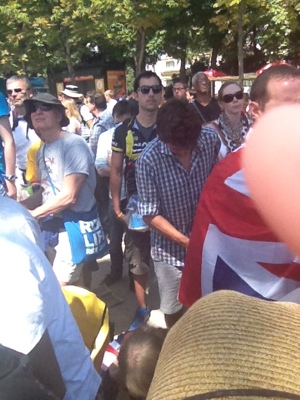
Almost 2pm. The stage hasn’t started yet and already people were standing 5 rows back.
1400. The stage starts, and it is televised on giant video screens (that are of much better quality and strategic placement than at the Amgen Tour of California – AEG, take note).
1500. The Caravan arrives!

And now the caravan! Led off by who else, le Maillot Jaune…

…who led out the Crédit Lyonnais Lion…

Here comes Haribo! This S’mores float was my favorite one.

Even Luxembourg helped sponsor Le Tour. Even though neither of our favorite Luxembourgers made it to Paris.

And here is the Boxerdog! The swag wagon I was most looking forward to seeing.

This… well I have no words for this one.
Helene offers some of her apple chips, and I nonchalantly say ‘sure’, hoping she didn’t notice the roar of borborygmi emerging from my belly. I play it cool, trying not to give away that I am not truly human, but a Hobbit.
Now thirsty, I remember my swag stash of Haribo Orangina Pik candies from Chartres. I acknowledge the underappreciated hydration capacity of one’s own salivary glands.

Paris Stage 20 survival kit. Haribo for hydration, and earplugs for the Caravan (It’s REALLY loud).
After about 20 caravans, you realize this is one long live action commercial/advert break, before the stage begins in earnest.

We watched the pre-Paris race action on a screen over by the VIP tents. The tree was slightly inconvenient. But worth the tradeoff of several hours of shade.
By this time I am still famished! But we dare not move lest we lose our primo spot in the front row. No saving places here!
Reminding myself that this is a circuit race in which we will see the riders 16 times helps give some encouragement to wait in the sun and heat.

Helene (@HeleneBarrette) and I hid behind her Canadian flag for a respite from le soleil.
Helene makes note that this is the most sedate Paris crowd she’s seen in her 5 years of attending Stage 20/21. We discuss why this might be the case.

This was a nice view to have for 6 hours.
ASO apparently has chosen the man with the thickest French accent to announce, and his über-Frenchified pronunciations of non-French names is nearly inscrutable. No Dave Harmon here to strive for native language name pronunciation.
Ravikiran offers some biscuits! Hobbit stomach is sated, albeit fleetingly.
For all the talk about proper race hydration for the cyclists, equally important is the hydration strategy for fans holding their place in the front row for 8 hours without taking a ‘besoin naturel’. It’s best to arrive ever-so-slightly dehydrated (with bladder empty, of course), and stay just ahead of your insensible losses (mainly sweat and respiratory losses from trashtalking with the Brits about Wiggins – kidding! kidding!) throughout the day.
It is hot. We really start to melt. Miraculously, people are still civil, and no one passes out of heatstroke. Would be a shame to lose my front row spot in order to do BLS/CPR.
The Aujourdhui en France (newspaper) caravan plays the song Champs-Élysées as they ride by. It is a nice change from the usual club music blating from the speakers. Everyone sings along, “Oh, Champs-Élysées… OHHH, Champs-Élysées…”, then forgets the rest of the lyrics.
Finally someone from the caravans says “Where are zee Eeengleesh?” to get the crowd going.
I finally figure out what this caravan is missing. Marching bands!
“Tres chaud” – announcer. Yes indeed. Ah, finally a cool breeze. Fangirling is such a sacrifice.
60 km to go. Almost within Paris city limits. The anticipation after so many hours of waiting descends upon the crowd, as we watch the Peloton cross the Seine. Word gets out that Sky “plans to do something for George” on their Champs entrance.

As the race approached the Champs for the first circuit, everyone was at the ready.
We see on the screen George Hincapie and Chris Horner emerge from the Concorde tunnel in front, knowing that they will soon pass us. We all wonder aloud, “Why Chris Horner?” along with everyone else watching the race.
George & Chris whiz by, and I miss a photo of them. I curse technology.
Jens in the break. Of course, how perfect. The Peloton eases the chase. In the back of my head I’m thinking, how can they let Jens go? If anyone is wily enough to steal the Champs from the Peloton, it’s him…
I ponder how awesome it is to be here in person to witness Jens in the breakaway for nearly all the circuits.
Each circuit, I concentrate on picking out one rider in the Peloton blur that passes. Sagan, Nibali, Menchov, Pinot, Millar, Cav, George…
During the last few circuits, I count the time between the breakaway and the main group, like lightning before thunder. One-one thousand, two-one thousand, three…
Helene and I realize how inaccurate the reported time gap on the video screen is. I think, is that true of every race we watch on TV?
Finally the bell lap. Their speed is exhilarating to see from our front row vantage point.
When Wiggins takes his turn in the train, the Brit fans roar. It does look pretty cool on the screen.
And the entire crowd erupts when Cav crosses the finish line. By this time I am leaning completely over the fence cheering toward the Champs, using my navel as a fulcrum. It’s a minor miracle I don’t topple over. The crowd is ecstatic and so is Cav as he rides by us.
Meanwhile, the non-Sky teams convene in little ad hoc meeting areas in front of us, discussing their coulda-woulda-shouldas of their race.
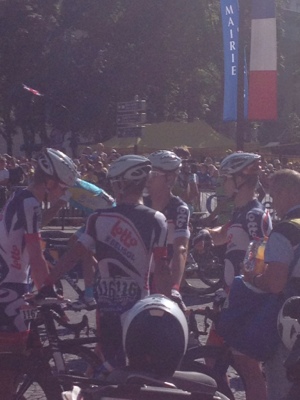
Lotto a bit subdued immediately after the race.
The Lotto Boyz seemed none too happy about the sprint. Hendo most of all. I tried to yell out a congrats to him for finishing his first Tour, but he still had smoke coming out of his ears. Don’t think he heard me.
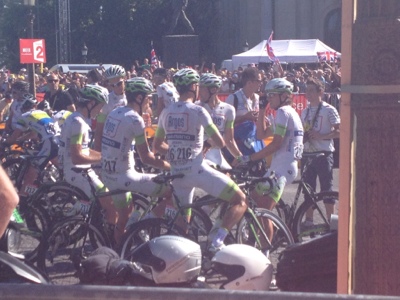
Argos Shimano had a similar team debriefing after the stage.

Big George is interviewed after his record-setting 17th and final Tour. What is next for him???
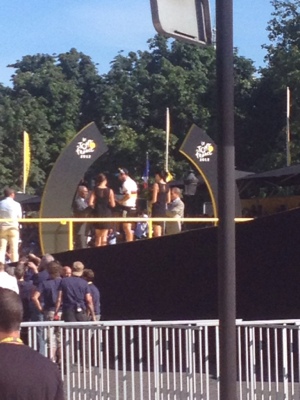
Stage podium with Cav. Right before this we had a glimpse of him showing off Delilah to the press corps. We saw him, Papparazi-like, as he handed her off to Peta before the podium.
The jersey podiums are next. As we are non-VIP plebes (though well-positioned ones), we see the podiums only from the back. Still it’s a thrill to see them live and witness how they effect the vision trick that makes them look like they are right under the Arc de Triomphe (they are a good km or two from it).
Peter Sagan’s Maillot Vert is first. I sigh, thinking of the days of his relative obscurity when he first started winning stages in the Tour of California in 2010. He has arrived, big time.
Thomas Voeckler’s Maillot à Pois is next. The French faithful show their gratitude to their Chou-Chou. At one point he brings up his kids, one in each arm, each child clad in dots. Podium Kids is one of the best things about the podiums.
Then Tejay gets his Maillot Blanc. I admit I’m equivocal about his win, even as an American. I’m still mentally processing the psychology of his non-support (how’s that for a doublespeak term?) for Cadel during TackGate. But I’m reserving judgment for now, positive and negative.
Then the final podium. Nibali-Froome-Wiggins together. From our view behind the podium, Chris Froome appears very subdued and still. Or maybe we’re just projecting. But I suspect not.
Oh dear. God save “God Save The Queen”. And I’m not even talking about the performer chosen to sing it. [Why didn’t they just play Queen’s guitar version? It’s the best one.] I’m talking about all the British isles of fans surrounding us, all singing in different keys and tempi. At one point I had a 360 degrees video of their caterwauling, but I botched that recording too. I curse technology again.

This was our view of the Podium presentation, during God Save The Queen. We couldn’t see Wiggo’s look askance, sadly.
For many fans, the best part of Paris is the Lap of Honor, in which each team (in reverse order of team placing, then ending with the Maillot Jaune winning team) rides the Champs circuit at a slow, leisurely pace, waving hello to the fans, taking photos/videos of the crowd with their phones, toting their children in their arms or the handlebars, and even riding to the curb to interact with fans and their flag-waving fellow countrymen. I’ve included a few photos here, but will likely detail my particular Lap of Honor observations in a separate post.
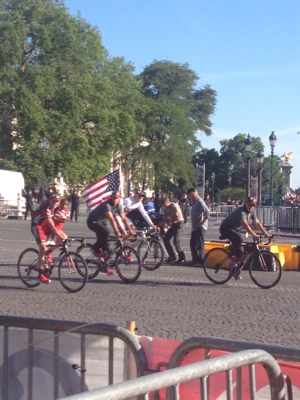
BMC’s lap of honor, with Tejay carrying the Stars and Stripes, and Cadel with little Robel in tow.

Pierre Roland acts as emcee, drumming up some chees for Thomas Voeckler’s entry during Europcar’s lap of honor.

And then Mr. Pois de Panache himself.
My personal highlight (hey, it’s my blog so I get to highlight whomever I want): Liquigas rolls by for their Lap, and I gasp as I see Nibali ride over toward us to greet his fan club just around our corner. Unfortunately he is just out of our sightline as he meets his flagbearers, but then he rides by us with a wave and a smile. I swoon. Helene concedes that he is indeed quite good-looking. (See Helene, I told you!)
After the festivities are over, Helene and I bid each other enchantée/adieu until the next race we meet up again (perhaps Montreal??). I am FAMISHED and scarf down an official Tour de France footlong:

Don’t you dare put ketchup on that dog! Extra mustard, SVP.
I make a weak attempt at stalking the team buses, foiled by sundry barricades and gendarmerie. I’ve never taken to groupie-ing, but I do get insanely jealous when I see people with great pictures & stories from their stalking efforts. It’s just not my skillset. So on the way back to my flat I fill the void of incipient post-Tour blues by stalking Hermès bags instead.

Ooh, that Birkin Vert will go nicely with my souvenir Sagan Maillot Vert…
Next: Tour de Hermit Epilogue. The Lap of Honor.

![]()
